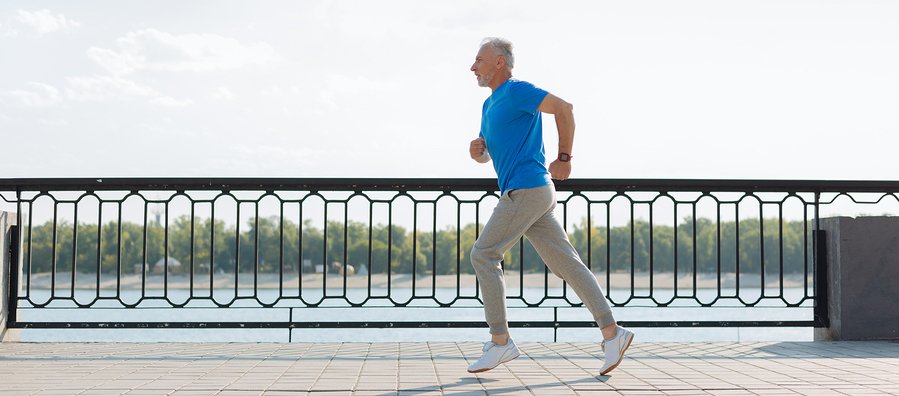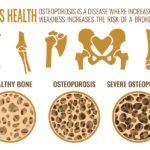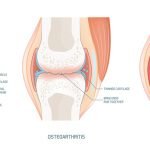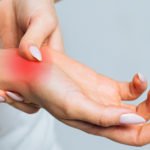Article Summary:
- A new study shows that men develop osteopenia at the same rate as women.
- Men may have some protection from osteoporosis due to their larger bones and hormones.
- Bone loss is preventable as you age with weight-bearing exercise, vitamin D, calcium, less alcohol consumption, and a hormone-balancing formula.
Men With Osteoporosis
When you think of osteoporosis, the image of a frail elderly woman may come to mind. But the reality is that we don’t just go from being strong and healthy to weakened and stooped overnight. There is a long process we undergo, starting in our 30’s, of losing bone mass over time. And you might be surprised to learn that new research shows this potentially serious bone loss is experienced by men just as much as women.
The study, which took place at the University of Mississippi in Oxford, found that osteopenia, a condition characterized by low bone density, may be occurring in similar rates in both middle-aged men and their female peers.1Bass, Martha A.; et al. “Bone Mineral Density Among Men and Women Aged 35 to 50 Years.” Journal of the American Osteopathic Association. June 2019. Accessed 2 June 2019. http://jaoa.org/article.aspx?articleid=2735169. These results are based on an investigation that included 173 men and women between the ages of 35 and 50 residing in the Oxford area.
Bone density scans of the subjects’ hips showed that 28 percent of men and 26 percent of women had lower than normal bone mass. This was an unexpected turn of events, as bone density issues have long been considered mainly a women’s issue. Unfortunately, the study was limited by its small and mostly white population sample, but it should nonetheless make men think about their risk of losing bone density, too.
Although osteoporosis is certainly more of a problem in women, this research offers evidence that osteopenia (a less severe form of osteoporosis) may be just as prevalent in men. And it confirms earlier findings, such as those of a 2018 study at Army Hospital in New Delhi, India, which showed that 40 percent of men over 55 had low bone mass and nine percent had osteoporosis.2Kotwal, Narendra; et al. “A Prospective, Observational Study of Osteoporosis in Men.” Indian Journal of Endocrinology and Metabolism. Jan-Feb 2018. Accessed 3 June 2019. http://www.ncbi.nlm.nih.gov/pmc/articles/PMC5838913/. Osteopenia might not always progress to osteoporosis, but it is still dangerous because it increases the risk of fractures.
Why are Men Less Likely to Develop Osteoporosis Despite Having Low Bone Mass?
Men gain some protection from developing osteoporosis simply because their bones are typically larger and denser than those of women. Keep in mind that one of the risk factors for osteoporosis is having a thin, small-boned stature. But osteoporosis may also be less common in men because of hormonal differences. Women undergo the process of menopause over the course of several years and their levels of estrogen drop substantially during this period. Men, on the other hand, generally experience a much slower decline in testosterone levels, not to mention the fact that their estrogen levels increase as they age, which may be part of the reason they do not develop osteoporosis at nearly the same rate as women over the age of 65.
Preventing Bone Loss and Low Bone Mass as We Age
Peak bone density typically occurs in our 20s, and after that a very gradual progression of loss takes place. But with a little effort, we can maintain greater bone mass as we age. A few key ways for both men and women to keep bones strong include:
- Doing regular weight bearing exercise, such as walking or playing tennis, will work not only your muscles, but also help retain bone density.
- Making sure your body is producing an adequate amount of vitamin D, which is mainly triggered by exposure to sunlight. Try to spend 15 to 20 minutes a day outdoors without sunscreen to absorb the necessary rays of sun. And if you don’t get enough sun exposure, be sure to supplement with vitamin D3. 1,000 to 2,000 IU of vitamin D3 daily is not too much. It’s difficult to overdose on vitamin D at these levels.
- Eating a diet rich in calcium, which helps prevent the loss of bone mass, focusing on foods such as leafy green vegetables like kale and collard greens, salmon, sardines, and almonds. Calcium supplements and dairy, on the other hand, may not be a good way to go. Magnesium and boron supplements, on the other hand, do help.
- Limit alcohol consumption, as heavy drinking has been shown to increase the risk of developing osteoporosis over time.
- You also might want to limit your intake of fluoridated water. Studies have shown that although fluoride “technically” increases bone mass and density, the evidence is very strong that fluoride intake can actually double the incidence of hip fractures,
- Take a daily hormone balancing formula that corrects testosterone imbalances that occur over time, which in turn can contribute to keeping your bone mass intact as you age.
References
| ↑1 | Bass, Martha A.; et al. “Bone Mineral Density Among Men and Women Aged 35 to 50 Years.” Journal of the American Osteopathic Association. June 2019. Accessed 2 June 2019. http://jaoa.org/article.aspx?articleid=2735169. |
|---|---|
| ↑2 | Kotwal, Narendra; et al. “A Prospective, Observational Study of Osteoporosis in Men.” Indian Journal of Endocrinology and Metabolism. Jan-Feb 2018. Accessed 3 June 2019. http://www.ncbi.nlm.nih.gov/pmc/articles/PMC5838913/. |












Thank you for the info.
I have read that Vitamin K2 MK-7 will help direct calcium out of the blood and to the bones.